Copyright (c) Hyperion Entertainment and contributors.
AmigaOS Manual: Workbench Printers
There are many types of printers that can be used on the Amiga. Your choice of printer and the software that controls it (the printer driver) should accommodate all the types of printing you intend to do. If you want to produce specialized output, such as graphics and PostScript files, some additional configuration steps are required.. This chapter provides the following information:
- Setting up your printer
- Configuring your printer
- Connecting your printer
- Choosing and activating a printer driver
- Using the Preferences editors to make your printer settings
- Using printer escape sequences to implement special printer features
Setting Up Your Printer
When setting up a printer with your Amiga, follow these four general printer setup steps:
- Configure the printer using the controls on the printer itself.
- Connect the printer or printers to the Amiga.
- Selected and activate the printer driver.
- Make the proper Preferences editor settings.
Configuring Your Printer
All printers have switches or other controls on them to let them adapt to various hardware and software setups and to suit your personal needs. Front panel controls typically set the print font, spacing, mode (draft or near letter quality), and other final print options. The control's settings can usually be overridden by the software you use to print. Other printer controls, such as DIP switches, affect lower-level parameters that cannot be overridden, such as:
- The character set used
- How linefeeds are handled
- Printer emulations
Consult your printer manual to determine the optimum settings. Every printer is different; with most, a certain amount of experimentation is necessary to determine the correct configuration. Two general rules to follow:
- If your printer model is not among those for which the Amiga has a specific printer driver, but the printer offers emulation of various other printers, set the printer to emulate one of the supported printers.
- Set the printer to use a USA or International character set. Do not set it for your country's character set; this is handled by the Amiga printer driver.
Connecting Your Printer
Most printers are Centronics-compatible and connect to a parallel port. However, a printer can also be connected to a serial port. You can have more than one printer connected, but you can print to only one at a time. Use the Printer Preferences editor to switch between parallel and serial printing. This is described on page 9-8. If you need to do a serial connection, you must also use the Serial Preferences editor, described in Chapter 5, to configure the interface.
Follow the instructions in your printer's documentation for using the proper printer cable. Connect it to the appropriate port on the Amiga according to the Amiga hardware manual.
If you have more than one printer connected to your Amiga or you have a printer connected to a port other than the standard serial or parallel ports, see "Connecting Multiple Devices" below. When using an expansion device that offers additional serial and/or parallel ports, the device's documentation should explain how to connect these ports.
Connecting Printer Output Devices
The standard Amiga printer output device is PRT:, which sends its input to the currently selected printer drive. You can bypass the Amiga printer driver by redirecting output to PAR: or SER:, which sends the output directly to the parallel or serial port, respectively, without any alteration. This is useful, for example, if you need to send a raw PostScript file to a PostScript printer attached to either port.
Connecting Multiple Devices
It is possible to use both a parallel and a serial printer with your Amiga system. You can also use more than one parallel or serial printer by using an expansion device that offers additional serial and/or parallel ports. On such systems, you must use the Printer Preferences editor to select which output device to use. On systems with additional ports, the device's documentation should give the unit number assignments for each port in your system. You then can use the Unit options of the Printer and Serial Preferences editors to specify the correct printer. The following table contains instructions for switching between printers on systems with more than one.
| System Configuration | Switching to a Different Printer |
|---|---|
| Standard ports only with one serial and one parallel printer | In the Printer Preferences editor, switch the Printer Port gadget between Serial and Parallel. Change serial settings in the Serial Preferences editor if necessary. |
| Additional parallel ports and more than one parallel printer | Enable the Printer Preferences editor's UNIT Tool Type, then enter the parallel port number for the desired printer in the Device Unit gadget in the Printer Preferences editor. |
| Additional serial ports and more than one serial printer | Enable the Printer Preferences editor's UNIT Tool Type, then enter the serial port number for the desired printer in the Device Unit gadget in the Printer Preferences editor. Change serial settings in the Serial Preferences editor if necessary. |
For more information on the UNIT Tool Type, see the descriptions of the Printer Preferences editor in this chapter and the Serial Preferences editor in Chapter 5.
Printer Drivers
A printer driver, which is selected in the Printer Preferences editor, acts as a translator that enables the Amiga to communicate with a particular model of printer. Different printers require information in different formats. The printer driver takes the information from the Amiga and translates it into the proper format for the particular printer. The printer driver you select is used for both the text and graphic output.
Choosing a Printer Driver
The Amiga system software offers a wide variety of standard printer drivers for most of the commonly marketed printers. Some word processing and desktop publishing applications come with their own printer drivers. Commercial and freely distributable printer drivers are also available from third party vendors. These printer drivers may take better advantage of a printer's special capabilities than the standard drivers.
The Amiga printer drivers are named according to the printers and printer standards they emulate. For example, the EpsonX printer driver corresponds to the standards for Epson printers with an X in their name, such as FX-80.
The available printer drivers for the Amiga include the following:
| CalComp_ColorMaster | HP_DeskJet | PostScript |
| CalComp_ColorMaster2 | HP_DeskJetOld | Seiko_5300 |
| CanonBJ10 | HP_LaserJet | Seiko_5300a |
| CBM_MPS1000 | HP_PaintJet | Sharp_JX-730 |
| Diablo_630 | HP_ThinkJet | Tektronix_4693D |
| EpsonQ | ImagewriterII | Tektronix_4696 |
| EpsonX | NEC_Pinwriter | Toshiba_P351C |
| EpsonXOld | Okidata_2931 | Toshiba_P351SX |
| Generic | Okidata_92 | Xerox_4020 |
| Howtek_Pixelmaster | Okimate_20 |
To determine which printer driver you should use, first read the documentation that came with your printer for information concerning the printer standards it uses. If there are no corresponding printer drivers for your printer, you can choose the Generic printer driver. For many printers, this allows you to print plain text without graphics or other type styles, such as italics or boldface.
If you choose the Generic printer driver and your printer still does not produce output, you should check your other Printer Preferences settings and the cabling. Be sure to read the printer's documentation carefully. If you still have a problem, contact your dealer.
Activating a Printer Driver
A printer driver must be in DEVS:Printers (the Printers drawer in the Devs drawer of the Amiga's boot volume) for it to be available for use. Printer drivers are shipped in the Storage/Printers drawer found on either the Storage floppy disk or within the system floppy disk set.
On hard drive systems, the printer drivers are preloaded in either DEVS:Printers or Storage/Printers. If you reinstall software on hard drive systems, the Installer lets you select and load the printer drivers you intend to use. However, if you do not select any printer drivers during installation, none are loaded and any previously loaded printer drivers, except Generic, are deleted. To use a printer driver other than Generic, you must manually copy it from the Storage/Printers drawer into DEVS:Printers and double-click on it to activate it.
If the printer driver you need is not in DEVS:Printers, copy it from the Storage/Printers drawer. The following are instructions for copying printer drivers:
- Select the Workbench window and open the Devs drawer.
- Insert the Storage floppy disk or the software system disk containing the Storage drawer into your disk drive and open its window.
- Open the Storage/Printers drawer.
- Scroll through the printer drivers icons until you find the driver for your printer.
- Drag the appropriate printer driver icon over the Printer drawer icon in the Workbench Devs window.
On a single drive system, requesters ask you to swap the system disks to compete the copy.
On a dual floppy drive system, insert a disk in each drive to complete the copy.
Preferences Settings for Printers
There are four Amiga Preferences editors that you can use when setting up your printer and setting up how your printing appears:
| Printer | Specifies a printer driver, the serial or parallel port, and non-PostScript text settings. |
| PrinterGfx | Affects printing of non-PostScript graphics. |
| PrinterPS | Used only with PostScript printers. |
| Serial | Used only with Serial printers. The Serial editor is described in Chapter 5. |
Printer Preferences Editor
The Printer Preferences editor lets you select a printer driver, the printer port, and various text options. The settings made in the Printer Preferences editor (as well as PrinterGfx and PrinterPS) are defaults that are used when print settings have not been made elsewhere. Applications, such as word processors, typically provide corresponding options that override the Preferences settings. Figure 9-1 illustrates the Printer Preferences editor window.
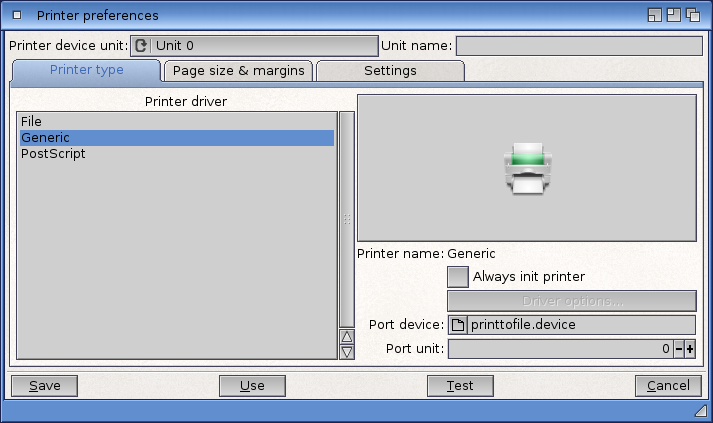
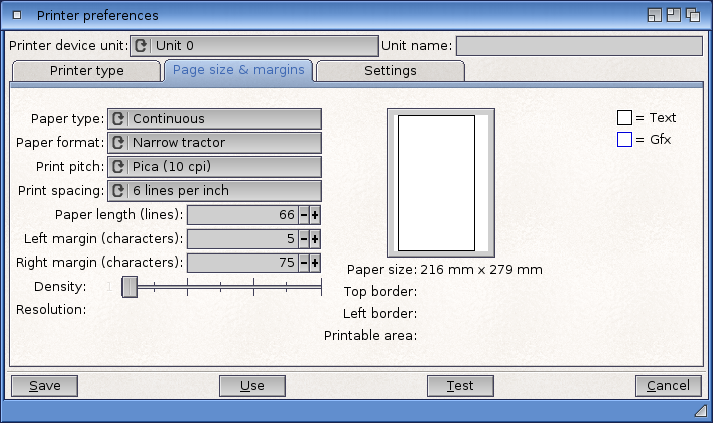
The Printer Type scroll gadget displays a list of available printer drivers currently installed in DEVS:Printers.
Select a printer driver by pointing to its name and clicking the mouse selection button. The selected driver is highlighted.
| Note |
|---|
| If you selected the PostScript printer driver, use the PrinterPS editor to make text and graphics settings. This overrides the settings made in the Printer Preferences and PrinterGfx Preferences editors. However, you must still select a Printer Port here. |
If a driver for your printer (or a printer that your printer emulates) is not in DEVS:Printers or the Storage/Printers drawer, select Generic.
The Printer Preferences editor window contains the following gadgets:
Printer Port
Specifies the type of port where the printer is attached: Serial or Parallel. If Serial is selected, you must also make sure that the serial transmission settings in the Serial Preferences editor are appropriate for your printer.
Print Pitch
Specifies the pitch, which is the number of characters printed per inch (cpi) horizontally. The higher the number, the narrower the characters. Choose between Pica, Elite, and Fine.
Print Spacing
Specifies the number of lines of text that are printed in one vertical inch of space. Select 6 lines per inch (lpi) or 8 lpi; the higher the number, the less space between the lines.
Print Quality
Determines the quality of the printout. Selecting Draft produces faster, lower quality printouts. Selecting Letter produces slower, higher quality printouts.
Paper Type
Specifies the type of paper used. The options are Continuous (tractor feed paper) or Single (individual sheets).
Paper Format
Specifies the size of paper used. Selecting Custom as the paper size can eliminate printing problems that occur with dot matrix printers.
If Custom is selected, be sure to specify in the Paper Length gadget the correct number of lines that fit on the paper.
Paper Length
The total number of lines of text printable on the page, including top and bottom margins. For example, 11-inch paper with 6 lines per inch has a Paper Length of 66 lines. To change the default value, select the gadget, delete the existing value, type in the new number, and press Return.
Left Margin
The width, in numbers of characters, from the left edge of the paper to the starting text position. The Print Pitch setting (number of characters in a horizontal inch) affects the size of the margin. For example, when Print Pitch is Pica (10 cpi), a Left Margin setting of 10 gives a one-inch margin. To change the default value, select the gadget, delete the existing value, type in the new number, and press Return.
Right Margin
The width, in number of characters, from the left edge of the paper to the position where the right margins is to begin. To change the default value select the gadget, delete the existing value, type in the new number, and press Return.
Device Unit
The Device Unit text gadget appears in the Printer Preferences editor only if the UNIT Tool Type for Printer is enabled. Use it to direct printing to the desired port when you have expansion hardware that provides additional parallel or serial ports. Enter the number for the printer port specified in the expansion hardware documentation.
printtofile.device
This device driver acts as a replacement for parallel.device. But instead of sending all data written to it to the parallel port, this driver will store it in a file the user is prompted to choose.
How to use it?
In the Printer preferences editor, click on the "Use custom device" button and enter "printtofile.device" as the "Port Device". Note that printer units cannot share a single printtofile.device unit number. Thus, for two printer units to print to a file, choose different printtofile.device unit numbers. Any number between 0 and 9 will do.
What happens when printing starts?
Each time the printer.device is opened and starts sending data to the output device, printtofile.device will open a file requester, prompting the user to enter the name of the file the data is to be stored in. This happens both for text output and for graphics dumps.
If the selected file already exists, the user will be prompted to choose the action to follow: the file can be overwritten, the new data can be appended to it, a new file name can be selected or printer output can be cancelled altogether.
PrinterGfx Preferences Editor
The PrinterGfx Preferences editor provides options to control the printing of graphics. Before using the PrinterGfx editor, be sure to select the printer driver for your printer with the Printer Preferences editor. Figure 9-2 illustrates the PrinterGfx Preferences editor window.
| Note |
|---|
| If you selected the PostScript printer driver, use the PrinterPS Preferences editor to make graphics settings. This overrides settings made in the PrinterGfx Preferences editor. |
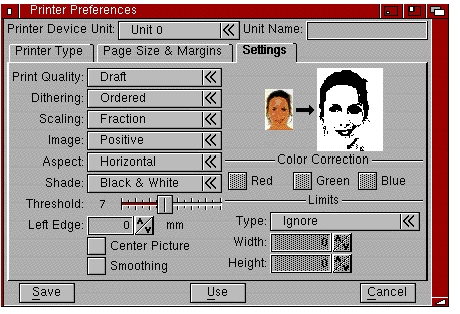
The PrinterGfx Preferences editor contains the following gadgets:
Dithering
Dithering prints patterns of dots in different colors (or different densities) so that they appear as one color or as shades of grey. This has the affect of smoothing out the picture and giving the impression of more colors. The available dithering options are:
| Ordered | The standard type of dithering. Color intensities are formed using an ordered pattern of dots. The dots can vary in color, but are of the same density and are printed in straight rows and columns. |
| Halftone | Color intensities are formed by varying the size and density of the dots. |
| Floyd-Steinberg | Color intensities are formed by a complex algorithmic formula. Floyd-Steinberg dithering yields smoother shading by distributing the intensities of each pixel throughout the dots comprising that pixel, as well as throughout neighboring dots. |
Figure 9-3 illustrates the results of the different dithering methods; the pictures were generated on a 300 dot per inch printer.
Halftone
Floyd-Steinberg
Figure 9-3. Dithering Methods
Scaling
Scaling is the process of changing the size of an image. The actual size of the printout is determined by the Limits setting, described on page 9-15. The available Scaling options are:
| Fraction | Closely matches the size you have set in Limits, possibly distorting the image. Pixels are enlarged or reduced as necessary. This option works best when printing pictures with extensive shading. |
| Integer | The number of dots in the printout is an integer multiple of the number of pixels on the screen. (If a picture on the screen is 320 x 200, the printed picture can be 320 x 200, 640 x 400, 960 x 600, and so on.) Selected this option when printing a picture that contains thin vertical and horizontal lines (such as a grid) or text. |
Image
Determines whether an image is printed normally or with a reverse shading. This option affects only Black & White and grey scale printing. When set to Positive, the image is printed as it appears on the screen. When set to Negative, the image is reversed, similar to a photographic negative.
Aspect
Determines the direction on the paper the image is printed. When set to Horizontal (often called Portrait), the image is printed as it appears on the screen. When set to Vertical (often called Landscape), the image is printed sideways.
Shade
Allows you to select the colors to print. Not all printers support these options. The available options are:
| Black & White | Colors are printed as either black or white, determined by the Threshold setting. Dithering has no effect. |
| Grey Scale 1 | Colors are printed in varying shades of grey. |
| Grey Scale 2 | This option supports a maximum of four shades of grey and is used for printing pictures designed using the A2024 monitor. |
| Color | Colors are printed as they appear on the screen. This can only be used with color printers. |
Threshold
Determines the colors on the screen that are printed as black or as white. This setting is effective only in Black & White mode.
Increasing the Threshold value causes more colors to be printed as black. Figure 9-4 shows the results of different Threshold settings.
Threshold = 8
Threshold = 13
Figure 9-4. Threshold Settings
Density
Selects the graphics print density. The lower the density, the faster the image prints on those printers with multiple densities. When a higher density is selected, more dots create a sharper image. However, it takes longer for the image to print.
This option is not supported by every printer.
Smoothing
Used to smooth any diagonal lines that appear jagged. This option is best suited for use with programs that do graphic dumps of text. When smoothing is turned on, printing may be slower.
Floyd-Steinberg dithering cannot be used with Smoothing.
Center Picture
Horizontally centers the printed picture on the page. Any value entered for the Left Offset is ignored when Center Picture is on.
Color Correction
Matches the colors on your printout more closely to the colors on the screen. Color correction can be used on red, green, or blue or on a combination of colors.
Color correction reduces the number of printed colors. When color correction is not used, all the available colors displayed by the Amiga can be printed on a color printer. For each color that is chosen for correction, several shades of that color are lost. The number of colors than can be printed is shown in the Colors gadget to the right of the color correction boxes.
Left Edge
Determines the distance of shift, or offset, the printed picture. This is similar to setting up a left margin. The Center Picture option disables Left Edge.
To enter the value, select the Left Edge gadget, delete the current value, enter the correct value, and press Return. Choosing Use Metric System? In the Settings menu lets you specify the value in millimeters rather than tenths of inches.
Limits/Type
Interprets the Width and Height limits, depending on the Type setting. The available options are:
| Ignore | Ignores Width and Height limits. The printed picture's size is the size requested by the application. The only restrictions are that its width cannot be greater than: (right margin - left margin) + 1 / characters per inch or mm Height is usually restricted to the length of the paper. |
| Bounded | The printed picture's size is bounded by the Width and Height limits. Width and Height are interpreted in tenths of inches by default or millimeters if Use Metric System? Has been chosen in the Settings menu. For example, if the printed picture can be up 4.0 x 5.0 inches, set Width to 40, Height to 50, and select Bounded. |
| Absolute | The Width and Height limits are interpreted as absolute values. For example, if the printed picture should be exactly 4.0 x 5.0 inches, set Width to 40, Height to 50, and select Absolute. This distorts the picture as needed to fit. To use this option fraction scaling should also be selected. Choosing Use Metric System? In the Settings menu lets you specify the value in millimeters rather than tenths of inches. You can, however, use Absolute to get a normal aspect ratio printout that is a specific width or a specific height, but not both. Set either the Width or Height limit to the desired dimension and set the other limit to zero. For example, if Width is set to 40 and Height to 0, then the printed picture is 4.0 inches wide and as tall as necessary for the correct aspect ration. If both dimensions are set to zero, the printed picture is as wide as possible and as tall as necessary to retain the picture's proportion. |
| Pixels | The Width and Height limits are interpreted as pixels. If one of these values is set to zero, the dame rules as for the Absolute option apply. The printout is the width or height specified and as tall or as wide as necessary to retain proportion. |
| Multiply | The Width and Height limits are used to multiply the source picture's width and height. For example, if you specified a Width of 2 and a Height 0f 4, the printed picture is two times the source picture's width in pixels and four times the source picture's height. |
| Width/Height | Lets you specify the dimensions of your printout. The value is interpreted as increments of tenths of an inch or millimeters, unless Pixels or Multiply is the selected Type. To enter a value, select the text gadget, delete the current value, type the correct value, and press Return. |
Hints for Faster Graphics Printing
- Lower the Density setting.
- Use the horizontal rather than the vertical Aspect setting.
- Set Shade to black and white if you are using a two color image. This is faster than grey scale or color printing.
- Use Smoothing for final copies only since it can double the printing time.
- Use Ordered or Halftone dithering because they do not increase printing time. Floyd-Steinberg dithering doubles printing time.
- Speed up a High Res screen print that uses more than four colors by moving the screen to the back of the display after printing has started. Press left Amiga+N to do this.
PrinterPS Preferences Editor
The PrinterPS Preferences editor, illustrated in Figure 9-5, allows you to control text and graphics printing on PostScript printers. Use this editor only if you have a PostScript printer and if you choose PostScript in the Printer Preferences editor.
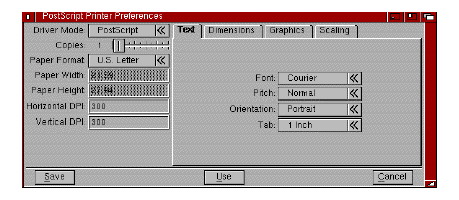
The PrinterPS Preferences editor has an additional item in the Settings menu: Measuring System. Its submenu lets you select Centimeters, Inches, or Points. The selected units are used to display values of your width, height, and margin settings. The default setting is Inches.
The PrinterPS Preferences editor contains the following gadgets:
Driver Mode
Driver Mode lets you select either PostScript or Pass Through. In PostScript mode the driver converts any text output it receives to PostScript and sends the results to the port selected in the Printer Preferences editor. The Pass Through option bypasses the PostScript driver and sends data directly to the port. The Pass Through option lets programs that output PostScript send their PostScript code directly to the printer.
Copies
This specifies the number of copies of each page to print, from 1 to 99.
Paper Format
Paper Format lets you define the size of the paper to be used: U.S. Letter, U.S. Legal, DIN A4, and Custom. Clicking on this gadget sets the values in the Paper Width and Paper Height cycle gadget to match the named format.
Paper Width and Paper Height
The Paper Width and Paper Height gadgets let you specify the exact paper dimensions for custom page sizes. These two gadgets are ghosted unless Custom is selected in the Paper Format gadget.
Horizontal DPI and Vertical DPI
The Horizontal and Vertical DPI gadgets allow you to specify the dots per inch to use in the printout. The driver uses this resolution for all its dithering and other processing. Using different DPI settings from those of your PostScript printer can result in printouts with a distorted aspect ratio.
Panel Cycle Gadget
The Panel cycle gadget lets you select from four additional option panels: Text Options, Text Dimensions, Graphics Options, and Graphics Scaling. The panel selected determines the set of gadgets displayed.
Text Options
Text Options gadgets are illustrated in Figure 9-6.
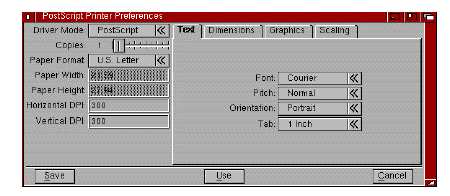
| Font | Select the font to use in your printout. These are built-in printer fonts and are used whenever text is sent to the printer. |
| Pitch | Select either Normal, Compressed, or Expanded character width. |
| Orientation | Select between Portrait or Landscape printing. Use Landscape printing for envelopes. |
| Tab | Specify how to handle tabs in the printed file. The available selections are 4 Characters, 8 Characters, 1/4 Inch, 1/2 Inch, and 1 Inch. Use inch settings with proportional fonts. |
Text Dimensions
Text Dimensions gadgets are illustrated in Figure 9-7.
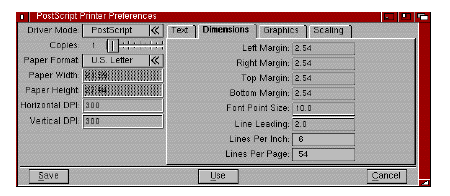
| Margin Gadgets | Specify all four margins for text printing. The values entered are relative to the respective edges of the paper, given the paper's width and height values specified previously. |
| Font Point Size | Specify the size of the font to use whenever text is sent to the printer. |
| Line Leading | Specify the amount of leading between lines of text. This is the distance in points from the bottom of one line to the top of the following line. |
| Lines Per Inch | Displays the approximate number of lines per inch, based on the values of the Font Point Size and Line Leading options. |
| Lines Per Page | This text displays area shows the number of lines printable per page, based on the values of the Font Point Size, Line Leading, Paper Height, Top Margin, and Bottom Margin. |
Graphics Options
Graphics Options gadgets are illustrated in Figure 9-8.
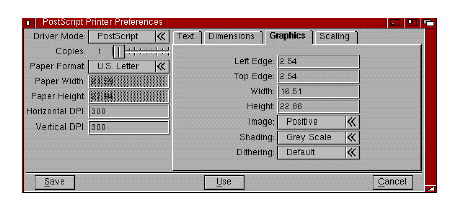
| Edge/Dimension Gadgets | Similar to the four Margin gadgets, but specifying the print region used for graphics printing. |
| Image | Positive/Negative. |
| Shading | Select between Black & White, Grey Scale, and Color. |
| Dithering | Select Default, Dotty, Vertical, or Horizontal dithering when Grey Scale shading is selected. Default is standard halftone shading. Dotty is similar to halftone shading, but with very large dots for a special effect. Vertical and Horizontal represent grey shades with closely-spaced vertical and horizontal lines of varying thickness. |
Graphics Scaling
Controls the size, orientation, and aspect ratio of the printed graphic image. The effects of the different options available under Graphics Scaling are shown by the four Sample Scaling images at the bottom right of the window. The shaded areas represent print regions of varying sizes and shapes. As you change the settings of the cycle gadgets, the rendering of the source picture changes accordingly. Figure 9-9 shows Graphics Scaling selected in the Panel Cycle gadget.
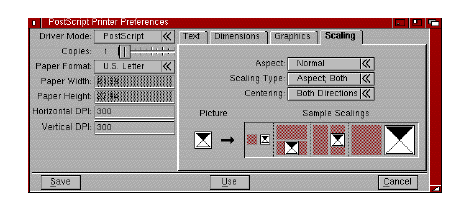
| Aspect | Specify Normal or Sideways for printing graphics. This operation is performed before any other graphic operations, including scaling. | ||||||||||||||
| Scaling Type | Select one of seven scaling types. All scaling types control how the picture is printed within the print region specified by the Edge/Dimension gadgets. The Aspect scaling types preserve the image's aspect ratio; the Fits types do not. The types are:
| ||||||||||||||
| Centering | Specify None, Horizontal centering, Vertical centering, or both. Centering is the last operation performed in the printing process, after scaling. |
Using Printer Escape Sequences
Each printer has its own set of escape sequences that are used in programs to control that particular printer's features. There are also standard ANSI escape sequences that control special printer features. By using the ANSI escape sequences, you can create a program that can be used on any printer for which there is a printer driver without making changes. We recommend using the standard ANSI escape sequences; however, do not confuse or mix your printer's escape sequences with these since they are likely to be different.
The Amiga printer device (PRT:) accepts standard ANSI escape sequences. The active printer driver translate ANSI escape sequences into control sequences your printer understands. For example, you can use escape sequences to set margins, turn on styles such as boldface or italics, and specify spacing. If a feature is not supported by your printer or printer driver, the escape sequence for it is ignored. Consult your printer documentation to verify the feature settings your printer accepts.
Escape sequences are typically used when you print to the printer device directly from the Shell or when you insert print commands into a program.
A typical escape sequence (to turn on boldfacing) is shown as follows:
Esc[1m
This indicates that you must press the following keys in sequence: Esc, [, 1, m. Escape sequences are case-sensitive. For example, to enter the following escape sequence:
Esc[4W
press the Esc, [, 4, and Shift+W keys.
Numbers inserted into the escape sequence are indicated by <n>. For example, the escape sequence used to set the left and right margins is:
Esc[<n>;<n>s
If you want to specify a left margin of 5 and a right margin of 75, type:
Esc[5; 75s
To send an escape sequence to the printer from the Shell:
1. Redirect the keyboard input to the printer by entering:
1> COPY * to PRT:
2. Wait until disk activity stops and type an escape sequence, such as:
Esc[2"z
To terminate keyboard output to PRT:, press Ctrl+\.
You can also create printer command files consisting of several escape sequences by redirecting keyboard input to a file. For example:
1. Redirect the keyboard input to a file:
1> COPY * TO RAM:EscapeFile
2. Enter the escape sequences, such as:
Esc[2"z (turns near letter quality on)
Esc[2w (turns elite type on)
Esc[1m (turns boldface on)
3. Press Ctrl+\ to terminate keyboard output to the file.
4. To send these escape sequences to the printer, enter:
1> COPY RAM:EscapeFile TO PRT:
Standard ANSI Escape Sequences
The following is a list of standard ANSI printer escape sequences for typical dot matrix printer text features:
| Feature | Escape Sequence | Name |
|---|---|---|
| Reset printer | Escc | aRIS |
| Initialize printer | Esc#1 | aRIN |
| Line feed | EscD | aIND |
| Return line feed | EscE | aNEL |
| Reverse line feed | EscM | aRI |
| Normal character set | Esc[0m | aSGR0 |
| Italics on | Esc[3m | aSGR3 |
| Italics off | Esc[23m | aSGR23 |
| Underline on | Esc[4m | aSGR4 |
| Underline off | Esc[24m | aSGR24 |
| Boldface on | Esc[1m | aSGR1 |
| Boldface off | Esc[22m | aSGR22 |
| Set foreground color | Esc[30m to Esc[39m | aSFC |
| Set background color | Esc[40m to Esc[49m | aSBC |
| Normal pitch | Esc[0w | aSHORP0 |
| Elite pitch on | Esc[2w | aSHORP |
| Elite pitch off | Esc[1w | aSHORP1 |
| Condensed fine pitch on | Esc[4w | aSHORP4 |
| Condensed off | Esc[3w | aSHORP3 |
| Enlarged pitch on | Esc[6w | aSHORP6 |
| Enlarged pitch off | Esc[5w | aSHORP5 |
| Shadow print on | Esc[6"z | aDEN6 |
| Shadow print off | Esc[5"z | aDEN5 |
| Doublestrike on | Esc[4"z | aDEN4 |
| Doublestrike off | Esc[3"z | aDEN3 |
| Near Letter Quality on | Esc[2"z | aDEN2 |
| Near Letter Quality off | Esc[1"z | aDEN1 |
| Superscript on | Esc[2v | ASUS2 |
| Superscript off | Esc[1v | aSUS1 |
| Subscript on | Esc[4v | aSUS4 |
| Subscript off | Esc[3v | aSUS3 |
| Normalize the line | Esc[0v | aSUS0 |
| Partial line up | Esc1 | aPLU |
| Partial line down | EscK | aPLD |
| US character set | Esc(B | aFNT0 |
| French character set | Esc(R | aFNT1 |
| German character set | Esc(K | aFNT2 |
| UK character set | Esc(A | aFNT3 |
| Danish I character set | Esc(E | aFNT4 |
| Swedish character set | Esc(H | aFNT5 |
| Italian character set | Esc(Y | aFNT6 |
| Spanish character set | Esc(Z | aFNT7 |
| Japanese character set | Esc(J | aFNT8 |
| Norwegian character set | Esc(6 | aFNT9 |
| Danish II character set | Esc(C | aFNT10 |
| Proportional spacing on | Esc[2p | aPROP2 |
| Proportional spacing off | Esc[1p | aPROP1 |
| Proportional spacing clear | Esc[0p | aPROP0 |
| Set proportional offset | Esc[<n> E | aTSS |
| Auto left justify | Esc[5 F | aJFY5 |
| Auto right justify | Esc[7 F | aJFY7 |
| Auto full justify | Esc[6 F | aJFY6 |
| Auto justify off | Esc[0 F | aJFY0 |
| Letter space (justify) | Esc[3 F | aJFY3 |
| Word fill (auto center) | Esc[1 F | aJFY1 |
| 1/8" line spacing (8 lpi) | Esc[0z | aVERP0 |
| 1/6" line spacing (6 lpi) | Esc[1z | aVERP1 |
| Set form length to <n> | Esc[<n>t | aSLPP |
| Perf skip <n> (n>0) | Esc[<n>q | aPERF |
| Perf skip off | Esc[0q | aPERF0 |
| Left margin set | Esc#9 | aLMS |
| Right margin set | Esc#0 | aRMS |
| Top margin set | Esc#8 | aTMS |
| Bottom margin set | Esc#2 | aBMS |
| Top and bottom margins | Esc[<n>;<n>r | aSTBM |
| Left and right margins | Esc[<n>;<n>s | aSLRM |
| Clear margins | Esc#3 | aCAM |
| Set horizontal tab | EscH | aHTS |
| Set vertical tabs | EscJ | aVTS |
| Clear horizontal tab | Esc[0g | aTBC0 |
| Clear all horizontal tabs | Esc[3g | aTBC3 |
| Clear vertical tab | Esc[1g | aTCB1 |
| Clear all vertical tabs | Esc[4g | aTCB4 |
| Clear all horizontal and vertical tabs | Esc#4 | aTBCALL |
| Set default tabs | Esc#5 | aTBSALL |
| Extended commands | Esc[<n>"<x> | aESTEND |
Extended Commands
An extended command lets you specify a printer escape sequence for your specific printer within an ANSI escape sequence. In this case, <n> represents the number of bytes in the command and <x> represents the actual command. In an extend command, one character equals one byte. Esc is one character. For example, if your printer recognizes Esc k 1 as the command to use a sans serif font, type:
Esc[3"Esck1
If you are entering extended commands within a program, be sure that the commands are applicable to the printer in use. A printer's documentation should list its supported escape sequences.